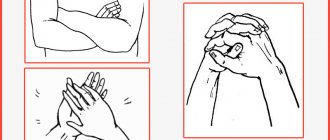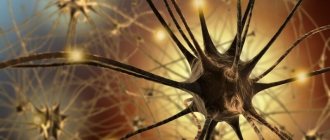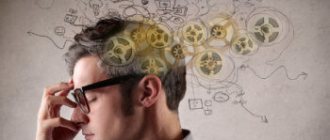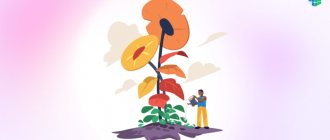“The left hemisphere of the brain is responsible for logical thinking, and the right hemisphere is responsible for creative thinking” - this “saying”, like many others like it, is very common not only among ordinary people, but also among specialists - even in books devoted to correct thinking , self-development and some other similar topics you can find a lot of them. But what is most interesting, surprising and strange is that these myths, one can put it bluntly, relate very, very little to the true state of affairs.
The myth that the cerebral hemispheres are functionally asymmetrical is one of the most popular myths regarding the brain that can be found today. Along with the myth that a person uses only 10% of his brain, he is, perhaps, a leader.
Despite this, even seemingly professional specialists with serious scientific knowledge and all kinds of degrees and titles often claim that this myth is the purest truth, and “stuff” it into the minds of ignorant people. The good news is that the myth about functional asymmetry of the cerebral hemispheres has been dispelled for quite some time. But let's not get ahead of ourselves.
What is the left hemisphere of the brain responsible for?
The left hemisphere is mainly responsible for analysis and logic. One hemisphere will always work more actively than the other.
The left hemisphere is responsible for:
- logical thinking;
- understanding only the literal meaning of words;
- reading and writing abilities;
- number and symbol recognition;
- language abilities;
- speech control;
- solving mathematical problems;
- analysis of all facts;
- processing information sequentially, in stages.
Mysteries and contradictions of the creative brain
Nadezhda Vyacheslavovna Markina, Candidate of Biological Sciences
“Chemistry and Life” No. 11, 2008
What happens in the brain of an artist who creates a brilliant painting? Or a poet who writes immortal lines that will touch people's hearts a century later? No matter how mysterious and incomprehensible the gift of God that overshadows a genius may be, he guides his hand through the activity of the brain. There is no other option. But creativity to one degree or another is inherent in every person. A child composes fables, a schoolchild works on an essay, a student completes his first independent research - all these are creative processes. Today, creativity is welcomed, and sometimes required, in any job - this word, borrowed from English, is increasingly used to denote creative abilities.
When defining creativity, different experts ultimately come to the same conclusion. Creativity is understood as the ability to generate something new, for example, unusual ideas, to deviate in thinking from stereotypes and traditional patterns, and to quickly resolve problem situations. Of course, the ability to create, or creativity, is a useful quality for a person, since it is what allows him to adapt to the world around him.
The first person to undertake an objective study of the phenomenon of creativity was the American psychologist John Guilford. At the end of the 50s of the last century, he formulated several criteria for creativity that can be assessed in psychological tests. The main criteria are: fluency - the ease of generating ideas, flexibility - the ease of forming associations between distant concepts, and originality - the ability to move away from stereotypes. Thanks to the work of Guilford and then Torrens, it became possible to measure creativity quantitatively and statistically. American psychologist E. Torrance is the author of the most widely used test for determining creativity.
It is believed that the basis of creativity is divergent thinking, that is, thinking that diverges along many paths. Divergent thinking occurs when one problem is solved in different ways, each of which can be correct. Apparently, it is the multiplicity of solution options that creates the opportunity to find original ideas.
Rex E. Jung, an assistant professor in the department of neurology, psychology and neurosurgery at the University of New Mexico, emphasizes the main feature of creative thinking: the solution comes in the form of “insight” (the English word “insight” is already widely used without translation). Eureka! yeah! - these words convey the state that occurs when a sudden guess appears in the brain like a flash.
The task of studying the brain organization and brain mechanisms of the creative process seems elusive. The possibility of “verifying harmony with algebra” and, in general, the ability of the brain to know itself are doubtful. But scientists are trying to approach this difficult task. It turned out that even for studying such subtle matter there are objective psychophysiological methods.
How creativity is studied
One of the first, and until recently, the main method of studying brain activity, was electroencephalography - recording the electrical activity of the brain through electrodes placed on the scalp. Rhythmic fluctuations of electrical potentials in order of increasing frequency are divided into several ranges: delta (0.5–3.5 Hz), theta (4–7.5 Hz), alpha (8–13 Hz), beta (13.5–30 Hz) and gamma (above 30 Hz). An electroencephalogram (EEG) is the total electrical activity of millions of neurons, each of which discharges to do its job. That is, figuratively speaking, this is the noise from millions of operating electric generators. But depending on the functional state, this noise may vary. Important indicators of EEG are powers in different frequency ranges, or, what is the same, local synchronization. This means that at a given point in the brain, neural ensembles begin to discharge synchronously. Spatial synchronization, or coherence, in a particular rhythm shows the degree of connectivity and coordination of neural ensembles of different parts of the cortex of one or different hemispheres. Coherence can be intrahemispheric and interhemispheric. The outstanding neurophysiologist A. M. Ivanitsky called the areas of greatest spatial synchronization the foci of maximum interaction. They indicate which areas of the brain are most involved in performing certain activities.
Then other methods appeared that made it possible to assess the functioning of various areas of the brain based on changes in local cerebral blood flow. The more active the brain neurons are, the more energy resources they require—primarily glucose and oxygen. Therefore, an increase in blood flow allows us to judge the increase in the activity of some areas of the brain during a particular activity.
resonance imaging (fMRI)
), which is based on the phenomenon of nuclear magnetic resonance, it is possible to study the degree of blood oxygenation in a specific area of the brain. The scanner measures the electromagnetic response of the nuclei of hydrogen atoms to excitation in a high-intensity constant magnetic field. As blood flows through the brain, it gives oxygen to nerve cells.
Since hemoglobin bound and not bound with oxygen behaves differently in a magnetic field, one can judge how intensely the blood delivers oxygen to neurons in different parts of the brain. Today, it is with the help of fMRI that most studies related to the organization of higher brain functions are carried out in the world.
Local cerebral blood flow is also studied using positron emission tomography (PET). Using PET, gamma quanta are recorded that arise from the annihilation of positrons formed during the positron beta decay of a short-lived radioisotope. Before the study, water labeled with a radioactive oxygen isotope 0–15 is injected into the patient’s blood. A PET scanner tracks the movement of an oxygen isotope in the blood through the brain and thus estimates the speed of local cerebral blood flow during a particular activity.
The creative process is an energy-consuming phenomenon, and based on this, we can expect that it is accompanied by activation of the cerebral cortex, especially its frontal lobes, associated with integrative processes (that is, with the collection and processing of information). But already the results of the first electrophysiological studies turned out to be contradictory: some saw an increase in the activity of the frontal lobes of the cortex during solving a creative task, others saw a decrease. The same applies to assessing cerebral blood flow. Some researchers demonstrated the involvement of the frontal lobes of both hemispheres in the process of performing a fluency task, while in other studies the opposite was true: only one was activated.
But the complexity of the problem does not mean that it cannot be approached. At the end of the 90s, at the Institute of the Human Brain of the Russian Academy of Sciences, under the leadership of N.P. Bekhtereva, work began on studying the brain organization of creativity. They were distinguished by their careful experimental design. To date, Natalya Petrovna’s students and colleagues have obtained statistically reliable and, most importantly, reproducible data.
At the IV World Congress on Psychophysiology recently held in St. Petersburg, an entire symposium was devoted to the brain mechanisms of creativity. Scientists from different countries presented different methodological approaches and varied results.
Alpha rhythm - peace or creativity?
Electrophysiologists do not have a clear idea of which EEG rhythms are primarily associated with creative activity, for example, how the basic rhythm of the human brain, the alpha rhythm (8–13 Hz), changes. It dominates in the human cerebral cortex in a state of rest with eyes closed and is characteristic of this particular state. Any external stimuli lead to desynchronization - suppression of the alpha rhythm. It would seem that the creative efforts of the brain should act on it in the same way. But Andreas Fink (Institute of Psychology at the University of Graz, France) presented the results of measuring alpha rhythm indicators when subjects solved a creative problem. The task was to invent an unusual use for ordinary objects, and the control task consisted of a simple characterization of the properties of objects. The researcher notes that more original, compared to less original, ideas were accompanied by an increase in the alpha rhythm in the frontal areas of the cerebral cortex. At the same time, in the occipital areas of the cortex, the alpha rhythm, on the contrary, weakened. Coming up with an alternative use for an object causes significantly greater changes in the alpha rhythm than characterizing its properties.
The scientist offers an explanation for why the alpha rhythm increases when solving a creative problem. Its strengthening means that the brain switches off from normal external stimuli coming from the environment and its own body, and focuses on internal processes. This state is favorable for the emergence of associations, development of imagination, and generation of ideas. And desynchronization of the alpha rhythm in the occipital areas may reflect the retrieval from memory of visual images needed to solve a problem. In general, an attempt to accurately localize “creativity zones” led the scientist to the conclusion that creativity is not tied to certain parts of the brain. Rather, it is accompanied by the coordination and interaction of the anterior and posterior cortical regions.
Changes in the alpha rhythm when solving creative problems were also assessed in the work of O. M. Razumnikova (Institute of Physiology, Siberian Branch of the Russian Academy of Medical Sciences, Novosibirsk). It turned out that a more successful solution corresponds to an increase in the initial power of the alpha rhythm, reflecting the preparation of the brain for work. When performing a creative task, on the contrary, desynchronization of the alpha rhythm occurs - its structure is disrupted and replaced by faster activity.
In the experiments of M. G. Starchenko and S. G. Danko in the laboratory of the Institute of Human Brain of the Russian Academy of Sciences under the direction of N. P. Bekhtereva, the subjects performed a creative task and a control task, which consisted of a similar activity, but without creative elements. In the most difficult creative task, scientists asked subjects to come up with a story from a set of words, and from different semantic fields that were not related to each other in meaning. For example, from the words: begin, glass, want, roof, mountain, be silent, book, leave, sea, night, open, cow, throw, notice, disappear, mushroom. The control task was to come up with a story from words of one semantic field, for example: school, understand, task, study, lesson, answer, receive, write, assessment, ask, class, answer, question, solve, teacher, listen. The third task was to reconstruct a coherent text from ready-made words. The fourth is in memorizing and naming words starting with one letter from the presented set of words. Without going into details, we can say that the creative task, unlike the control task, caused an activation reaction - desynchronization of the alpha rhythm.
a
.
More creative subjects ( top
) have higher alpha power in the right occipital region than less creative subjects (
bottom
).
b
.
The creative task - coming up with alternative uses for objects ( top
) is accompanied by greater alpha rhythm power than the control task - describing the properties of objects (
bottom
). The scale displays the amount of alpha rhythm power. Image: Chemistry and Life
In other experiments in the same laboratory, nonverbal, figurative creativity was examined in the following tests. Volunteers received two creative tasks: draw any picture using a given set of geometric shapes (circle, semicircle, triangle and rectangle) or draw given objects in an original way (face, house, clown). In the control tasks, you had to draw your own picture from memory and simply draw geometric figures. The results obtained by Zh.V. Nagornova indicate that an imaginative creative task, compared to a non-creative one, reduced the power of the alpha rhythm in the temporal zones. And according to data presented by Doctor of Biological Sciences O. M. Bazanova (Institute of Molecular Biology and Biophysics of the Siberian Branch of the Russian Academy of Medical Sciences, Novosibirsk), creative thinking is accompanied by an increase in the power of the alpha rhythm and synchronization in the alpha 1 range (8–10 Hz) in the right hemisphere . She examined whether individual alpha scores could be used as a measure of nonverbal creativity in the Torrance Complete Drawing Test. It turned out that individual average alpha frequency was associated with fluency, variations in alpha rhythm amplitude were associated with flexibility, and individual frequency was associated with originality in the opposite way in the group of high- and low-frequency subjects. Therefore, the author concludes, these two groups use different strategies when solving a nonverbal creativity task.
Is a fast brain a creative brain?
The largest number of results indicate a connection with creative activity by fast electrical activity of the cerebral cortex. This refers to the beta rhythm, especially the beta 2 rhythm (18–30 Hz) and the gamma rhythm (more than 30 Hz). N.V. Shemyakina worked with a test for verbal creativity - subjects came up with endings for well-known proverbs and sayings. And in her experiments, the creative task was accompanied by a change in the power of the high-frequency gamma rhythm. The figurative creativity task, according to Zh.V. Nagornova, increased the power of beta-2 and gamma activity in the temporal lobes.
Similar results were obtained in the experiments of S. G. Danko, candidate of technical sciences. He showed that creative thinking is not always associated with complexity of thinking. The creative task was to come up with your own ending to a well-known proverb (for example, “Better late than ...”) so that its meaning would completely change. In the control task, it was necessary to remember the existing ending. A complicated control task was also given, in which the text of the proverb was written in the form of anagrams (words with rearranged letters). The results of EEG recordings confirmed the hypothesis that creativity and task complexity manifest themselves differently. An indicator of creative thinking—an increase in the power of the gamma rhythm—was observed when a creative element appeared in the task, but was not observed when the task became more complex.
No neighbor's help needed
The extent to which areas of the brain distant from each other can be involved in joint creative activity can be judged by analyzing the spatial synchronization of neural ensembles in a range of different rhythms.
In the experiments of M. G. Starchenko in a creative task - composing a story from words of different semantic fields - spatial synchronization in the anterior areas of the cortex increased within each hemisphere and between the hemispheres. But the synchronization of the front areas with the back ones, on the contrary, was weakened.
Test for nonverbal creativity. Image: Chemistry and Life
In the task of nonverbal creativity (experiments by Zh.V. Nagornova), spatial synchronization in the creative task changed across all EEG rhythms. In the slow and medium ranges, intrahemispheric and interhemispheric synchronization increased. Perhaps this reflects the functional state of the brain against which creative work occurs. The interaction of the frontal and occipital regions in the slow delta rhythm, the researchers say, may reflect the process of retrieving figurative visual information from memory. To the greatest extent, figurative memory was involved in creating one’s own picture. And increased spatial synchronization in the theta rhythm range may be associated with emotional reactions during the performance of creative tasks. In fast beta and gamma rhythms, intrahemispheric synchronization is enhanced, and interhemispheric synchronization is weakened. This may indicate less interconnected work of the hemispheres in the process of nonverbal creativity, more independent processing of figurative information. Perhaps, experts say, interhemispheric synchronization in the frontal lobes decreases when searching for distant figurative associations and creating an idea for a drawing. It is possible that the frontal lobes may have an inhibitory effect on the process of nonverbal creativity. And the fact that the largest number of connections occurs in the left hemisphere can be associated with the specifics of the drawing using geometric shapes.
In the work of D. V. Zakharchenko and N. E. Sviderskaya (Institute of Higher Nervous Activity, Russian Academy of Sciences), EEG indicators of the effectiveness of performing the Torrens test - completing an unfinished drawing - were assessed. It turned out that high levels of flexibility and originality are associated with a decrease in the degree of spatial synchronization. The better the creative test is performed, the more pronounced these processes are. The explanation for this non-obvious result is that the brain needs to minimize external influences, including from other parts of the brain, in order to focus on solving a creative problem.
Increase ( in red
) and a decrease (
in blue
) in the power of rhythms when solving a creative problem compared to a non-creative one.
Above
: Image of your own picture.
Bottom
: image of given items. Image: Chemistry and Life
It turns out that neurons in different parts of the brain do not always need to unite to solve a creative problem. In the first stages, synchronizing work at a slower rhythm helps the brain reach the desired functional state. But during the creative process itself, it is necessary to get rid of some connections in order not to be distracted by external influences and to avoid excessive control from other parts of the brain. Neurons engaged in a creative task seem to say: “Don’t interfere, let me concentrate.”
Creativity zones: myth or reality?
Researchers received the first information about the localization of creative abilities in the brain not in an experiment, but in the clinic. Observations of patients with various brain injuries showed which areas of the cortex play a role in visual creativity. Thus, the parieto-occipital regions of the left hemisphere are responsible for the visual representation of an object. Other zones connect this representation with verbal description. Therefore, if, for example, the posterior parts of the left temporal cortex are damaged, a person can copy a picture, but is not able to draw it according to the instructions. The frontal lobes are responsible for thinking (extracting the semantic content of the picture) and drawing up a program of actions for the picture.
This is how Academician N.P. Bekhtereva described the state of the problem of mapping higher brain functions: “The study of the brain organization of various types of mental activity and states has led to the accumulation of material indicating that physiological correlates of different types of mental activity can be found in almost every point of the brain. Since the middle of the 20th century, debates about the equipotentiality of the brain and localization—the idea of the brain as a patchwork quilt woven from a variety of centers, including the highest functions—have not subsided. Today it is clear that the truth is in the middle, and a third, systemic approach has been adopted: the higher functions of the brain are ensured by a structural and functional organization with rigid and flexible links.”
The most information about the spatial organization of creative activity in the brain at the Human Brain Institute was obtained using the PET method. In the experiments of M. G. Starchenko et al. (N. P. Bekhtereva, S. V. Pakhomov, S. V. Medvedev), when subjects were asked to compose a story from words (see above), the local speed of cerebral blood flow was studied. To make a conclusion about the involvement of certain areas of the brain in the creative process, scientists compared PET images obtained during creative and control tasks. The difference in the image indicated the contribution of cortical areas to creativity.
Statistically significant differences in local cerebral blood flow in blood flow comparisons when subjects performed verbal tests with different creative loads: DW
- difference in cerebral blood flow when performing a creative task compared to a non-creative one.
RW
is the difference in cerebral blood flow during a more difficult non-creative task compared to an easier non-creative task. Image: Chemistry and Life
The results obtained led the authors to the conclusion that “creative activity is ensured by a system of a large number of links distributed in space, with each link playing a special role and demonstrating a certain activation pattern.” However, they identified areas that seemed to be more involved in creative activity than others. This is the prefrontal cortex (part of the frontal cortex) of both hemispheres. Researchers believe that this area is associated with the search for necessary associations, extracting semantic information from memory, and maintaining attention. The combination of these forms of activity likely leads to the birth of a new idea. Of course, the frontal cortex is involved in creativity, and PET has demonstrated activation of the frontal lobes of both hemispheres. According to previous studies, the frontal cortex is the center of semantics, and the right frontal lobe is considered responsible for the ability to formulate concepts. And the anterior cingulate cortex is believed to be involved in the process of information selection.
Summarizing the data from various experiments, N.P. Bekhtereva names several areas of the cerebral cortex that are more involved in the creative process. To navigate the topography of the cerebral cortex, they use the numbering of fields identified by the German anatomist Korbinian Brodmann (a total of 53 Brodmann fields - PB). PET data illustrate a connection with the creative component of tasks in the middle temporal gyrus (PB 39). Perhaps this zone provides flexibility of thinking and the connection of fantasy and imagination. A connection was also found with the creative process of the left supramarginal gyrus (PB 40) and the cingulate gyrus (PB 32). It is believed that PB 40 provides flexibility of thinking to the maximum extent, and PB 32 provides information selection.
Here is the data provided by Rex Jung, associate professor in the department of neurology, psychology and neurosurgery at the University of New Mexico. In his experiments, he used tests for inventing multiple uses of objects and for complex associations. The results identified three anatomical regions related to creativity: the temporal lobe, the cingulate gyrus, and the anterior callosum. In more creative subjects, an increase in the thickness of the anterior temporal lobes was found.
Right and left
Ideas about which hemisphere of the brain is more important for creativity vary widely. Traditionally, many experts share the opinion that the right hemisphere is more involved in the creative process. There is a completely logical explanation for this, since the right hemisphere is more associated with concrete, imaginative thinking. This idea is confirmed by experimental evidence. In most of the results obtained, during creative thinking, the right hemisphere is activated to a greater extent than the left.
Scientists have obtained some information about brain symmetry or asymmetry of creative activity from clinical cases. Although these results are mixed. Cases have been described where, when the corpus callosum (the structure that provides communication between the hemispheres) was excised for medical reasons, patients' ability to perform creative activity decreased. On the other hand, there are examples when suppression of the left hemisphere released the artistic creative activity of patients, their drawings became more original and expressive. And when the right hemisphere was suppressed, the originality of artistic creativity in the same patients sharply decreased. This supports the idea that the controlling left hemisphere inhibits the creativity of the right.
Fields of the cerebral hemispheres (according to Brodmann's classification). Fields 32, 39, 40 are most likely related to creativity. Image: Chemistry and Life
From this perspective, one can consider the creative capabilities of patients suffering from schizophrenia, in whose brain interhemispheric connections are weakened. Apparently, mental illness, transporting people into a special existentiality, removes some restrictions and releases the unconscious, which can be expressed in a surge of creative activity. However, modern experts are not inclined to exaggerate the importance of schizophrenia in creativity. Indeed, among brilliant artists and musicians, many suffered from mental illness, for example Van Gogh, Edvard Munch, but among patients in psychiatric clinics, truly gifted people are still rare.
With verbal creativity the situation is apparently even more complicated. Employees of N.P. Bekhtereva’s laboratory noted activation of both the right and left frontal lobes when performing a difficult creative task of composing a story from words (see above). Thus, complex verbal creativity requires the participation of both hemispheres.
Based on the results of his study, Andreas Fink notes that in more creative individuals, when performing a verbal creative task, large changes in the alpha range occurred in the right hemisphere. There were no such differences among less creative people.
Creativity, intelligence and personality
The problem of the relationship between creative abilities and the level of intelligence and psychological characteristics of the individual was studied by O. M. Razumnikova (Institute of Physiology of the Siberian Branch of the Russian Academy of Medical Sciences, Novosibirsk). She emphasizes that creativity is a complex phenomenon that is determined by many psychological traits, such as neuroticism, extroversion, and the search for novelty. First of all, it was interesting to see how the degree of creative ability is related to the IQ indicator of intelligence. In the process of creative thinking, existing knowledge and images must be retrieved from long-term memory to serve as raw material for new ideas. The breadth of this knowledge and the speed of information selection (as measured by IQ) increase the ability to generate unusual ideas through the depth of insight and use of concepts from different semantic categories. The strategy for searching for ideas based on information selection is determined by the interaction of different areas of the cerebral cortex
Personality characteristics from the point of view of psychophysiology depend on specific cortical-subcortical interactions. These are the “reticular formation - thalamus - cortex” connections that provide brain activation - the nature of these connections largely determines the degree of extra-introversion. Interactions between the cortex and the limbic system are responsible for emotional reactions and determine the degree of neuroticism.
The purpose of the work was to test the hypothesis about the influence of intelligence and psychological characteristics on EEG indicators of creative activity. Among the subjects, based on the results of completing a creative task, a group of creative and non-creative ones was identified. But in both groups there were individuals with both high and low IQ, both high and low neurotic, both extroverts and introverts. The relationships between creativity, intelligence, and personality type were mixed.
Subjects with high intelligence and creativity demonstrated increased spatial synchronization between the frontal and temporo-parietal-occipital regions in the beta 2 range. This appears to help them successfully retrieve information from memory and use it to generate original ideas through divergent thinking. Subjects with low intelligence and high creativity did not show such a picture. Perhaps their creative abilities are realized through a different mechanism.
In general, creative individuals are characterized by a wide variety of degrees of intelligence and psychological traits, which, according to the authors, indicates the flexibility of this thinking strategy.
Creativity is emotional
Many studies have shown that performing creative tasks produces stronger emotions than performing control tasks. This is confirmed both by verbal feedback from the subjects themselves and by registration of physiological indicators.
Jan R. Wessel from the Max Planck Institute for Neurological Research describes the results of recording electromyograms of facial muscles in subjects who solved a problem in a creative way, in comparison with those who solved it in the usual way - enumeration of options. In creative subjects, at the moment preceding the “insight” (insight), the facial muscles give off a strong emotional reaction. It arises even before realizing the solution and is much stronger than in those who solve the problem in the usual way.
It is not surprising that positive emotions stimulate creativity: they increase the fluency of thinking, speed up the retrieval of information from memory and its selection, facilitate the emergence of associations, that is, they contribute to the flexibility of thinking.
The influence of positive and negative emotions on EEG indicators of creative thinking was studied by N. V. Shemyakina and S. G. Danko. The subjects had to come up with original definitions for emotionally neutral, emotionally positive or negative words from another semantic field. In emotionally neutral creative tasks, they obtained a decrease in spatial synchronization in the high-frequency beta-2 range. The authors view this as evidence of the dispersal of attention in creative thinking. But with positive emotions, the picture changed and the spatial synchronization of the EEG in high frequencies increased.
Creativity and error detector
Another interesting aspect of the study of creative thinking is its interaction with an error detector, the mechanism of which was discovered by N.P. Bekhtereva back in the 60s of the last century. Apparently, in different parts of the brain there are groups of neurons that react to the discrepancy between an event and an action and a certain pattern or matrix. “You leave the house and feel that something is happening wrong - it’s the brain’s error detector that discovered that you violated the stereotyped actions and did not turn off the lights in the apartment,” explains Corresponding Member of the Russian Academy of Sciences, Director of the Institute of the Human Brain of the Russian Academy of Sciences S. V. Medvedev. The error detector is considered as one of the control mechanisms of the brain. How is it related to creativity?
The hypothesis of N.P. Bekhtereva, which is developed by her students, is as follows. In a healthy brain, an error detector protects a person from thinking in stereotypical, trivial situations in the course of ordinary life. With any learning, necessary restrictions are formed in the brain along with positive ones; they are implemented precisely with the help of an error detector. But sometimes his controlling work can become excessive. The error detector prevents the emergence of novelty, breaking through dogmas and laws, overcoming stereotypes, that is, it fetters creative thinking. After all, one of the main elements of creativity is a departure from stereotypes.
The operation of the error detector can be suppressed in various ways, including alcohol or drugs. It is no coincidence that many creative people have resorted and continue to resort to these methods of disinhibiting their brain. But there may be another way. “In the creator’s brain,” explains N.P. Bekhtereva, “a restructuring takes place, and the error detector begins not to suppress it, but to help it - to protect it from triviality, from “reinventing the wheel.” In this way, creativity not only transforms the world, but also transforms the human brain.”
Creativity can be developed
Not all people are equally talented, it is in their genes. Gifted people can be envied, but - and this is good news - you can develop and train your own creativity. Andreas Fink thinks so. Positive motivation, the use of special techniques such as “brainstorming”, relaxation and meditation exercises, humor and positive emotions and, finally, placing a person in situations that stimulate creative thinking are suitable for this.
A group of subjects were trained for two weeks, asking them to solve creative problems. In particular, they had to come up with names, titles, slogans, etc. Over time, they coped with the tasks better and better, and since the tasks were new each time, it is obvious that this is not the result of training, but of the development of creative abilities . Objective changes also occurred: as creativity was trained, the alpha rhythm in the frontal lobes of the brain increased in the subjects.
Increased alpha rhythm power in the brain after creativity training. Control group - left
, the experimental group is
on the right
. Image: Chemistry and Life
We have tried to very superficially outline the current state of the problem of the psychophysiology of creativity. It turned out to be difficult and sometimes contradictory. This is just the beginning of the journey. Obviously, gradually, as knowledge about the brain accumulates, a stage of generalization will begin and the picture of the brain organization of creativity will become clearer. However, the point is not only in the complexity of the subject of research, but also in its nature. “It is possible,” writes N.P. Bekhtereva, “that no high technologies of today or tomorrow will save from some diversity in results due to individual variations in the strategy and tactics of the brain in the “free flight” of creativity.”
The author expresses gratitude to the Director of the Institute of Human Brain of the Russian Academy of Sciences, Corresponding Member of the Russian Academy of Sciences S. V. Medvedev for his comprehensive assistance, Candidate of Psychological Sciences M. G. Starchenko, Candidates of Biological Sciences N. V. Shemyakina and Zh. V. Nagornova for assistance and provision of materials .
The nature of the left hemisphere
Left-hemisphere people are often emphatically rational and reasonable. They write a lot and willingly, they easily remember long texts, and their speech is correct. They are characterized by a heightened sense of duty, responsibility, integrity, and the internal nature of processing emotions. They often occupy administrative positions, but they lack flexibility, spontaneity and spontaneity in expressing feelings. They prefer to act according to pre-drawn up schemes and stencils, and have difficulty rebuilding their relationships.
How to develop the left hemisphere of the brain
Since the main specificity of the left hemisphere is logical thinking, generalization and analysis, exercises aimed at its formation will include all kinds of logical tasks.
Neurogymnastics. Train your brain with your body. Neurogymnastics includes warming up for the hands and fingers. It has a beneficial effect on memory and attention and helps coordinate the work of the brain, synchronizing the activity of both halves.
Habitual actions with an unusual hand. Try, for example, brushing your teeth or using a smartphone with your non-working hand (left if you are right-handed, and vice versa). This engages the right brain, helping to develop lateral thinking.
Mind cards. A graphic structured display of key information differs from a simple outline in that in the process of creating it, the brain uses two hemispheres at once - the left one is responsible for the logical structure of the mind map.
Logic problems. Studying Euler's theory of sets and circles helps you think consistently and logically, as well as make informed decisions.
Verbal counting. Mathematical calculations, carried out without the help of additional devices and devices, also contribute to the development of the left hemisphere of the brain.
Soldiers of the invisible front
At the back of the brain is the cerebellum
.
Its volume is approximately one-eighth the size of the cerebral hemispheres. Despite its small size, this part of the brain controls coordination of movements
(the joint work of all muscles) and
the sense of balance
.
Thanks to the work of the cerebellum, a person can stand on his feet, maintain balance and move around. The brain stem
is located under the cerebral hemispheres and behind the cerebellum.
It connects the spinal cord and brain and controls all the functions that are necessary to maintain life in the body. The trunk is responsible for the involuntary work of muscles during breathing, heartbeat, food digestion and blood circulation. It works automatically and without interruption
.
How to prolong youth?
One of the mechanisms leading to aging is the death of nerve cells. The less a person strains his brain, the larger this process becomes. Find out how to stop this process and delay old age.
The brain stem is also responsible for sorting and distributing messages that the brain receives from the rest of the body.
Another notable area of the brain is the hippocampus
.
This paired formation, located in the temporal lobes of the hemispheres, controls memory
.
More precisely, by transferring information from short-term memory storage to long-term memory. The pituitary gland
is located on the lower surface of the brain - in a special bony cavity called the sella turcica.
The size of the pituitary gland is very small - no more than a pea. Its task is to control the production and release of all hormones
in the body.
Produces the pituitary gland and its own hormones - for example, growth hormone. The hypothalamus
is located practically in the geometric center of the brain.
It synchronizes the work of the nervous and endocrine systems of the body, working closely with the pituitary gland. For example, it is responsible for a kind of internal thermometer that maintains the temperature of the entire body
. If it increases, the hypothalamus sends a complex neurohormonal message that stimulates sweating. If it decreases, it gives a command for muscle tremors.
How to develop the right hemisphere of the brain
The goal is to achieve harmonious functioning of both hemispheres of the brain. Exercises to improve the functioning of the right hemisphere of the brain help suppress the dominance of the left, but they should not inhibit logical and sequential thinking too much.
The simplest exercises for developing the right hemisphere of the brain:
- if imagination and creative thinking are insufficient, visiting art galleries, museums and other creative events is recommended;
- the development of the right hemisphere of the brain stimulates drawing (there is also a “mirror” image technique, when the drawing is reproduced simultaneously with both hands), writing various stories or poems;
- To develop the right hemisphere, a right-handed person can perform everyday activities using mainly the left half of the body (this exercise is not suitable for a left-handed person).
Exercises
- So, in order to improve your creative side, you should visit exhibitions, museums, art galleries, and, of course, try yourself in writing poems, stories, and practice drawing, even if it’s abstract and understandable only to you. Dancing helps coordinate movements, which also has a beneficial effect on development.
- Start practicing visualization techniques that will help you achieve your goals faster and also help you develop your ability to fantasize and daydream. This is easy to do, just read the article first, where I talk in detail about all the nuances of the practice.
- Meditation is not easy for people who have well-developed logical thinking, but it is very effective for them. And not only to expand the boundaries of consciousness, the ability to move away from a clear structure and think three-dimensionally, but also to improve the quality of life and health. Start with a very simple meditation focused on breathing and concentration. You can find detailed instructions here.
- Massage your left ear to help activate the right side of your brain. Suitable in cases where it is necessary to take a creative approach to solving any issue and rely on your intuition.
- Creativity is not limited to drawing and poetry, read jokes and watch humorous programs, laughter will not only activate the brain, but also improve well-being, preventing the onset of depression. Besides, are you aware that people who use humor and sarcasm in their speech have a high level of intelligence?
- When listening to music, try to listen to your feelings and breathing. Let images, associations and pictures circle freely in your head, do not control them, trying to get rid of them. Just watch them, like an unwitting spectator of a performance organized by your consciousness and subconscious.
- Try online simulators for brain development. It is very convenient and interesting to spend time on the computer or phone for your own benefit.
How to determine which hemisphere is dominant
— The right hemisphere is the creative hemisphere. It's melodic, it's intuitive and it's emotional. And the left hemisphere is logic; it is very important that it is the speech hemisphere. Emotionally, this is a more positive hemisphere. Determining which hemisphere is dominant is quite simple - clasp your hands and see which finger is on top - your right hand or your left. If it is left, then your right hemisphere is dominant, but if the finger of your right hand is on top, then the left hemisphere is dominant. It always crosses paths,” says neuropsychologist Svetlana Shishkova in the program “Association of Practical Psychologists and Coaches.”
Which hemisphere of your brain is dominant can also be determined using a test. We invite you to watch the video carefully. If the figure rotates clockwise, your left hemisphere is dominant. Rotating counterclockwise means your right hemisphere is dominant. If the figure rotates alternately in one direction or the other, this is a sign of equivalent work of both the right and left hemispheres of the brain.
An integrated approach to the development of both halves of the brain
As I already said, it is important to coordinate the work of both halves in order to expand their capabilities and functions for which they are responsible. Then you will be provided with a creative approach to solving even the most complex problems, and the speed and efficiency of information processing will also increase.
- Sit comfortably with a straight back, choose a point in front of you, you will have to concentrate on it. After about a minute, try using your peripheral vision, without taking your eyes off the selected point, to see what is to your left, and then to your right.
- With one hand, stroke your stomach, and with the other, perform tapping movements on your head. Slowly at first to adjust, building up the pace over time.
- Also, the development of both hemispheres will provide you with the following task: place the finger of one hand on the tip of your nose, and with the other hand grab the ear opposite to it. For example, the right hand should take the left ear. As soon as you take it, clap your hands and do the same, changing the position of your hands. That is, the fingers of a completely different hand touch the nose, exactly the same pattern with the ears.
- Stretch your arms in front of you, draw a square in the air with one of them, for example, and a circle with the other. When you feel that you have made progress, come up with new figures to master.









